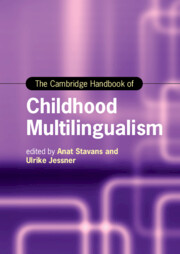Book contents
- The Cambridge Handbook of Childhood Multilingualism
- Cambridge Handbooks in Language and Linguistics
- The Cambridge Handbook of Childhood Multilingualism
- Copyright page
- Contents
- Figures
- Tables
- About the Editors
- Contributors
- Acknowledgments
- Multilingualism Is Not Bilingualism +1: An Introduction
- Part One Becoming and Being a Multilingual Child
- Part Two Cognition and Faculties in Multilinguals
- Part Three Family Language Policy
- 11 Establishing and Maintaining a Multilingual Family Language Policy
- 12 Parental Input in the Development of Children’s Multilingualism
- 13 Multilingualism, Emotion, and Affect
- 14 Siblings’ Multilingual Discourse
- Part Four Language(s) and Literacy of Multilingual Children through Schooling
- Part Five Socialization in Childhood Multilingualism
- Part Six Multilingual Children’s Landscape
- Subject Index
- Country Index
- Language Index
- References
12 - Parental Input in the Development of Children’s Multilingualism
from Part Three - Family Language Policy
Published online by Cambridge University Press: 18 August 2022
- The Cambridge Handbook of Childhood Multilingualism
- Cambridge Handbooks in Language and Linguistics
- The Cambridge Handbook of Childhood Multilingualism
- Copyright page
- Contents
- Figures
- Tables
- About the Editors
- Contributors
- Acknowledgments
- Multilingualism Is Not Bilingualism +1: An Introduction
- Part One Becoming and Being a Multilingual Child
- Part Two Cognition and Faculties in Multilinguals
- Part Three Family Language Policy
- 11 Establishing and Maintaining a Multilingual Family Language Policy
- 12 Parental Input in the Development of Children’s Multilingualism
- 13 Multilingualism, Emotion, and Affect
- 14 Siblings’ Multilingual Discourse
- Part Four Language(s) and Literacy of Multilingual Children through Schooling
- Part Five Socialization in Childhood Multilingualism
- Part Six Multilingual Children’s Landscape
- Subject Index
- Country Index
- Language Index
- References
Summary
The linguistic input parents provide to their children is crucial to the development of multilingualism. This chapter focuses on multilingualism in families where children either receive input in two or more home languages that are different from the environment language(s) or grow up in a bilingual community and have at least one additional home language. The chapter discusses quantity and quality of parental input as well as challenges in measurement. It reviews aspects of parental input, drawing upon Spolsky’s (2009) interrelated components of family language policy (FLP) – language ideologies, language management, and language practices. Parental attitudes, beliefs, and language ideologies impact on motivation and goal-setting in relation to the input they provide to their children. Language management is addressed through an examination of models of multilingual upbringing and parental input strategies. The implementation of FLP is reflected in actual language practices within the family. These are considered not only from the parental perspective but also from the children’s reactions to their parents’ input, as child agency plays a substantial role in the eventual success of parents’ strategies and practices.
Keywords
- Type
- Chapter
- Information
- The Cambridge Handbook of Childhood Multilingualism , pp. 278 - 303Publisher: Cambridge University PressPrint publication year: 2022
References
- 1
- Cited by



